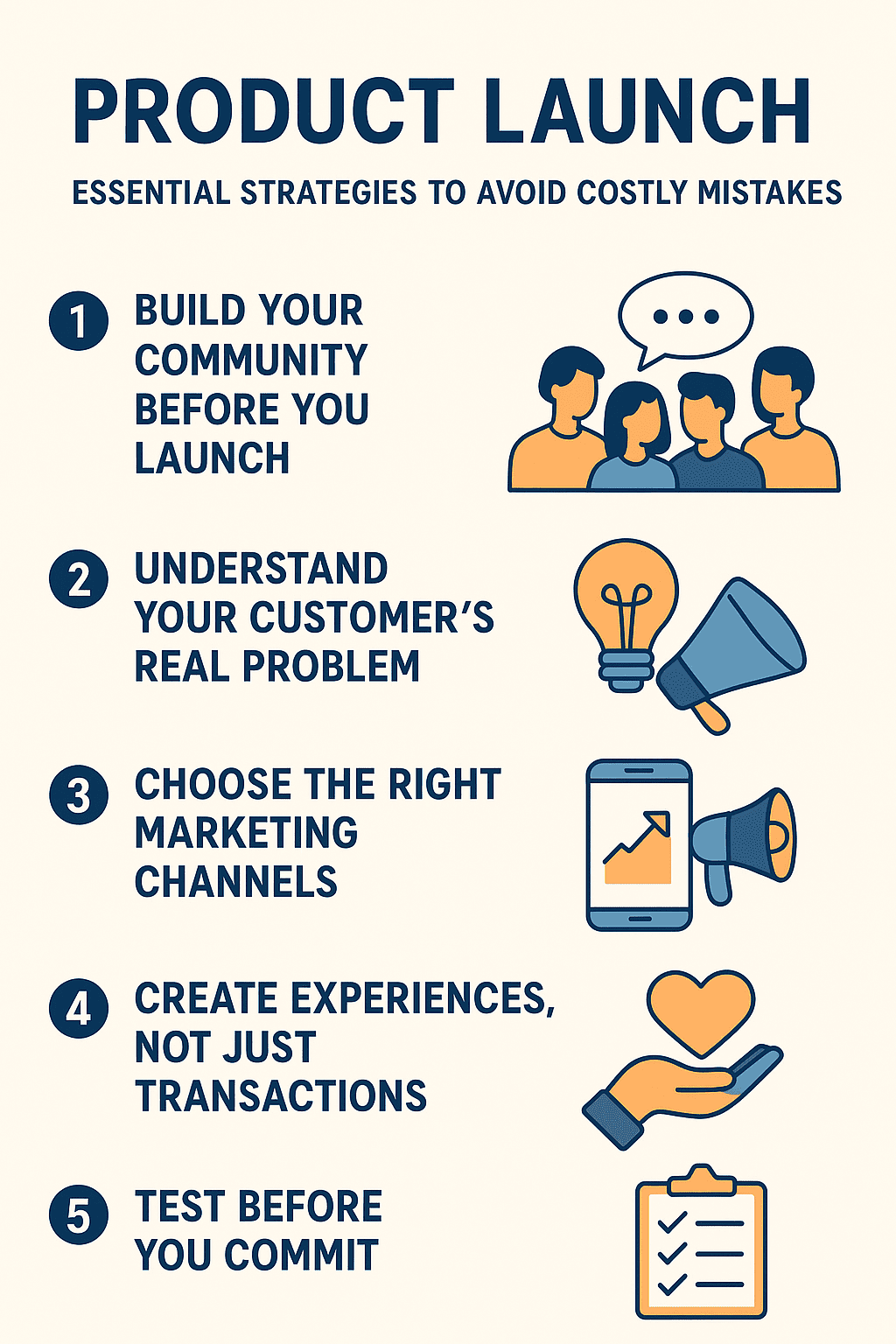Bringing a new offering to market goes beyond just creating something great. A successful product launch requires careful planning, deep customer understanding, and smart execution. Many Indian businesses invest significant time and money into developing their products, only to stumble during the product launch phase. The good news? Most common mistakes are avoidable.
Let’s explore the key principles that separate successful product launches from disappointing ones.
1. Build Your Community Before You Launch
The biggest mistake businesses make is waiting until their product launch to start building relationships. Smart entrepreneurs know that community building should begin long before launch day.
Start by creating excitement around your idea early. Share your journey on social media platforms like Instagram, Facebook, or LinkedIn. Let potential customers see what you’re building and why it matters. This “pack the snowball tight” approach means starting small, testing if there’s genuine interest, and then expanding based on real feedback.
Consider creating a WhatsApp group or Telegram channel where early supporters can give input on your product. Their feedback during the pre-product launch phase can help you refine your offering and messaging. When launch day arrives, these community members become your first customers and brand ambassadors.
The lesson is clear: Don’t assume a great product will automatically find customers. Build relationships first, then launch.
2. Understand Your Customer’s Real Problem
Many product launches fail because businesses market to the wrong audience or solve the wrong problem. You might have an excellent solution, but if you’re talking to people who don’t need it, or using messaging that doesn’t resonate, your launch will struggle.
Before your product launch, invest time in truly understanding your target customer. What keeps them awake at night? What frustrates them daily? What would make their lives genuinely easier?
Sometimes the answer surprises you. A product designed for adventure seekers might actually appeal more to busy parents looking for convenience. A luxury item with bold branding might perform better with subtle, understated design. You won’t know until you ask.
Use preorders, waitlists, and customer surveys to test your messaging and value proposition. Create sample content and see how people respond. Join online communities where your target customers hang out and observe their conversations.
The key principle: Design for your customers, not for yourself. Their needs should drive every decision in your product launch strategy.
3. Choose the Right Marketing Channels
A common product launch mistake is assuming what worked for others will work for you. The marketing landscape in India is diverse and constantly evolving. What succeeds on Instagram might fail on LinkedIn. What works in metro cities might not resonate in tier-2 and tier-3 towns.
Some businesses spend lakhs on fancy advertisements without understanding where their customers actually spend time. Others expect social media to go viral without building a foundation of genuine content and engagement.
For medical or health-related products, direct advertising might face restrictions. In such cases, focus on education, search engine optimization, and partnerships with credible professionals. Build trust through valuable content rather than flashy promotions.
For consumer goods, short-form video content on platforms like Instagram Reels, YouTube Shorts, or Josh can create massive awareness. But this requires consistency and authentic storytelling, not just promotional content.
The principle here: Meet your customers where they already are, using platforms and formats they naturally engage with. Don’t force your product launch into channels that don’t align with customer behavior.
4. Create Experiences, Not Just Transactions
The most memorable product launches create emotional connections, not just sales. Indian consumers value authenticity and story. They want to know the “why” behind your product, not just the “what.”
Instead of spending your entire budget on press releases that might get ignored, consider hosting an event, even a small one. Invite potential customers, tell your story, and let them experience your product firsthand. Create moments worth sharing on social media.
These experiences don’t have to be expensive. A simple meetup at a local café, a pop-up stall at a community event, or a live session on Instagram can work beautifully. The goal is creating genuine human connections around your product launch.
Keep samples or products with you wherever you go. Strike up conversations. Hand out samples. Ask for honest feedback. These grassroots efforts often generate more impact than expensive advertising campaigns.
Also, consider building a student or youth ambassador program. Young people are naturally enthusiastic, content-savvy, and well-connected. They can amplify your product launch message authentically within their networks.
5. Test Before You Commit
Many businesses make huge investments in inventory, packaging, and marketing materials before validating their product launch assumptions. This approach is risky, especially for small businesses and startups.
A smarter approach: Test everything first. Create a minimum viable version of your product. Show designs to potential customers before finalizing. Use preorders to validate demand before manufacturing at scale.
Social media makes testing easier than ever. Post about your upcoming product launch and gauge reactions. Share design options and ask followers to vote. Create a “coming soon” campaign and measure signups.
This testing phase serves two purposes: It validates your assumptions and builds anticipation for your product launch. By the time you officially launch, you already have interested customers waiting.
6. Stay Flexible and Ready to Pivot
Even with thorough planning, your product launch might not go as expected. Markets change. Competitors emerge. Customer preferences shift. The ability to adapt quickly separates successful launches from failed ones.
If your initial marketing strategy isn’t generating traction, be willing to pivot. If customers ask for features or changes you hadn’t considered, listen carefully. If one platform isn’t working, try another.
The best product launch strategies balance consistency with flexibility. Stay true to your core value proposition while remaining open to tactical changes in execution.
7. Build for Long-Term Relationships
A successful product launch isn’t just about first-month sales numbers. It’s about establishing foundations for lasting customer relationships. Every interaction during your launch period sets expectations for your brand’s future.
Respond promptly to customer queries. Deliver on your promises. Show appreciation for early adopters. Create opportunities for customers to provide feedback and feel heard.
These early customers become your brand’s most valuable assets. They provide testimonials, refer friends, and offer honest feedback for improvement. Treat them well, and they’ll support future product launches too.
The Bottom Line
A successful product launch isn’t about perfection, it’s about connection. It’s about understanding your customers deeply, meeting them where they are, and building genuine relationships alongside selling products.
Start by building community early. Ensure you’re solving the right problem for the right people with the right messaging. Choose marketing channels where your customers naturally spend time. Create memorable experiences rather than just transactions. Test your assumptions before making big investments. Stay flexible enough to pivot when needed.
Remember, your product launch is just the beginning of your customer relationship journey. Make it count by prioritizing authenticity, customer understanding, and emotional connection over flashy gimmicks.
As you prepare for your next product launch, focus less on the noise and more on the signal, the genuine human connections that turn first-time buyers into lifelong brand advocates.
Image Credits: Created By Chat GPT
🔗 For more articles on startup growth, fundraising strategies, and business insights for Indian founders, visit: Udyamee India Magazine










